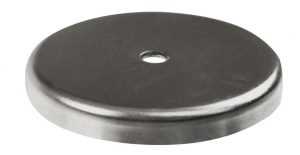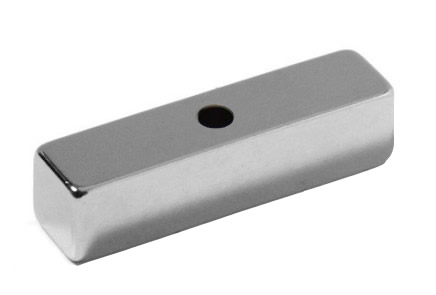If you are the one percent of the magnet business represented by someone replacing a magnetic latch in your cabinet kitchen cabinet, this information is not for you. If on the other hand you are building kitchen cabinets or any other industrial application that uses a magnet, read on!
Today’s magnets are strong, lightweight, and inexpensive. They are a commercial commodity. This means they are mass produced in a wide variety of sizes, types, and strength. Because they are mass produced chances are the magnet you want is being made somewhere by someone to a standard shape or size for your application. How to find that magnet is what this article is all about.

Most Magnets are made overseas and are sold and distributed through well-established channels. Working your way up that chain is important to finding good Value. For the one percent of the magnet business that is in repair or replacement then big box retailers and neighborhood hardware’s are where to start. For small quantities (less than 1,000-10,000 magnets) then an industrial supplier like Monroe Engineering will serve as a good resource. Where the manufacturer of a product using lots of magnets goes is the stock and sell distributor. This is the partner that has the relationship with the manufacturer you need. Because their business is based on very high volumes, they will offer the best combination of cost, timing, and quality.
When you reach out to a distributor the more information you provide the better served you will be. With that in mind here is “what you need to know to order a magnet”.
Standard Magnet Shapes
Each of the shapes listed comes in a wide variety of strengths and sizes. Every magnet starts life as one of these shapes. You can do secondary processes like a half dome on a bar, but that will require a tooling and process fee. Not a problem if you are buying millions, but a big cost driver at low volume. Standard magnets shapes are:
Arcs
Discs
Blocks
Cylinders/Rods
Bars
Strips
Rings
Spheres
Cubes
Cones
Flexible strips and sheets
Adhesive backed strips and sheets
Common Magnet Coatings
Magnets are very hard and in addition to chipping and breaking they can corrode or “rust”. Nearly all magnets are coated or painted for appearance and longevity. These coatings are:
Nickel: If your Magnet is bright silver it is coated with Nickle steel
Plastic: Any color you can imagine but most are black/brown
Rubber: Also, typically a dark color
Molded plastic or rubber: Magnets can be imbedded in products during plastic injection molding.
Magnet Categories, Types, and Styles and Applications
Unlike biology which gives us definitions of subgroups like genus and species, manufacturing terms and descriptions are rarely so straightforward. Because magnets are so widely used in so many applications, buying them would start with what your magnet is doing. Here are the basic categories of Magnets:
Industrial Lift Magnets: These are used for material handling in a manufacturing or production environment. There are two sub types. Both are “switched” so the magnet can be made inert. Electromagnetic lift magnets require a source of electricity. These magnets can be made very strong to lift very heavy loads. If, however, the electricity goes away so does the magnetic attraction and the load heads toward the floor. More commonly used is a pair of magnets inside a casing with a mechanical lever to reverse the Polarity of two magnets inside. These magnets are in widespread use in many Industries. They are rated by load capacity in Kilograms and pounds. They are typically made to hold three times the rating.
Industrial Sweeping and Tank Magnets: Machine Shops and metal fabricators generate metal “chips” which if they do not imbed themselves in a dirty floor are best picked up with a magnet. Industrial platers and coaters use magnets on the end of a hoist to pick up small metal parts lost in the tanks.
Pot Magnets: Pot magnets are the attaching of a magnet inside a steel cover. The steel cover then becomes the attaching point for things like hooks, studs, fasteners, and clips. These are used in households, office settings, manufacturing. Basically, they work anywhere you want to hang or attach something lightweight to metal.
Permanent Magnets: A permanent magnet means just that. It will retain its magnetic characteristics unless it is exposed to extreme temperature.
Electro Magnets: A magnet that is inert until an electrical charge is applied using a coil around a steel or Iron core. These can be made very powerful and can lift a train off the tracks or pick or launch and airplane off the deck of a carrier.
Temporary Magnet: Becomes magnetic when in the presence of a magnetic field. Rub a paper clip on a magnet and for a short period of time it will retain the magnetic property, albeit very weakly.
Motor Magnets: Typical in the shape of an arc or radius depending on the size of the motor. These can be tiny or gigantic, but every motor has them and there’s a lot of motors out there. Motor magnets are far and away the most common application for magnets in terms of percentage of magnets used at 35% of all magnets made.
Catches, Latches, and Clasps: Plastic encased magnetic latches and catches are used in furniture, cabinets and appliances universally. They are typically “light duty” magnets made to be strong enough to hold a small door closed but light enough to pull open by hand. They are made by the billions to standard sizes and strengths. Less than 10% of all magnets made are in these application
Electronics: This is the largest and most varied category. Every electronic device uses magnetic energy. DVD players, Televisions, X ray machines, Switches, Relays, Solenoids, Sensors, Cell Phones, Wave Guides, and on and on. To say the world operates on magnets would not be far from the truth.
Heavy Duty Magnets: Just about any magnet that lifts a load heavier than a human can is considered heavy duty.
Light duty Magnets: Think small, any magnet a human can manipulate easily would be light duty.
Rare Earth Magnets: Todays lightweight and powerful magnets exist because some minerals can be magnetized to a greater degree than steel or Iron alone. This can further improve by combining some of them. The development of these magnets included the process by which they are made, which was patented. Most rare earth magnets have been produced only under license to these patents. Rare Earth Minerals are just that. Unlike coal there are small deposits spread around the planet with most in Asia. The rare Earth Magnets are:
Neo: Made from Neodymium, Iron and Boron. Neodymium is a mineral used both in lasers and magnets. By far the most common of all the rare earth magnets.
Ceramic Ferrite: The ceramic component resists corrosion so this magnet does not require extra coating. A tradeoff between power and cost.

Smco: Samarium Cobalt performs 2 times better at high temperatures than Neo and is more stable in performance over a range of temperature
Alnico: One of the early rare earth magnets made primarily of Aluminum, Nickle, and Cobalt. Resistant to corrosion and chemicals while stable up to 535 degrees. These are still used in Industrial settings and things like guitar pickups.
Horseshoe Magnets: The universal symbol of the magnet was simply a way to align the poles of a magnet for strength while making it easy to grasp. Simple, elegant, and effective for its time.
How Magnets Are Rated for Load
Magnets are rated several ways and unless you are an engineer the basic unit of measure is lbs. Or kilograms of force required to separate a magnet in full contact with a direct pull. Note the words “Direct Pull”. I was once challenged to pull apart two small but powerful magnets with my hands. Since magnets do not resist shear as well as direct force, I simply slid them apart sideways. Getting them back together became the problem. That is why a refrigerator magnet might be hard to peel off but can be slid around.
Sometimes magnets are not in direct contact with the item being lifted. The ability of the magnetic field to hold a given amount of weight through an air gap Is also measured. That is why your refrigerator magnet will only hold so thick a stack of documents. The magnetic field must reach through the thickness of paper.
Ultimately a magnet is measured by its “Maximum Energy Product”. This is the number of Mega Gauss Oersteds. (mgoe) The higher this value the greater the magnetic field and relative strength of the magnet will be.
Modern Neo Magnets are rated with the letter N followed by a number. The highest current rating is N-52. If the rating is followed by a letter that denotes its relative resistance to temperature. If there is no letter it is considered to meet the std for that rating.
Should you want to check the breakaway force of a magnet the Magnet Distributor and Fabricator Association has published a std. MDFA-101-95
At the end of the day “you can never have too much magnet” when it comes to matching a magnet to an application
How Magnets Work
Magnets started as a naturally occurring mineral in the form of Lodestone. The earth itself is a giant magnet. Modern magnets use different materials to achieve their great strength, but the principle of their performance is the same as the lodestone discovered about 600 BC Not all minerals are magnetic. Magnetic material like lodestone is not uniformly present in the earth’s crust. By simple definition, a magnet “Is an object that has an energy field which attracts metals like Iron, steel, and cobalt.” The word object is used because inert material can be magnetized by the creation of an electrical field around it. The “magnetic field” is a flow of energy outside the body of the object going from one pole to the other……. Negative to Positive. A metal object within that field is attracted to the object generating the field. Modern magnets are made of powder that is charged after aligning the particles to a uniform direction, literally making millions of tiny magnets work together once the powder is compressed and heated in a process called sintering. The stronger the magnet the greater the pull and reach of the magnetic field.
Choosing a Magnet Partner
Now that you know the basics of how to describe your magnet application and requirements it is time to find a partner. First, talking to the factory is out of the question in most applications. Most magnets are produced in Asia under license. They are bought in bulk and standard sizes by stock and sell distributors. The distributors are only as good as their Asian suppliers, their ability to stock a wide array of products is a function of financial strength. Because of their complexity it is quite easy to make a mistake when speccing a magnet on the internet. Do not hesitate to reach out to a search result that meets the basic criteria of your magnet. If a human being picks up the phone quickly and seems knowledgeable you are on your way to a good low-cost solution.
